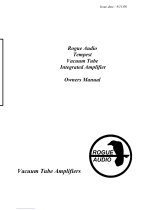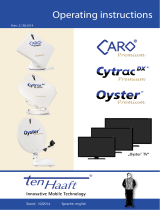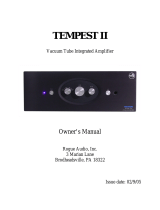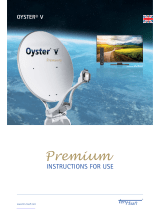
TLP 1 • PVA 2
one button for balance and display brightness, three tone controls,
and ends with the Mute and Contour buttons. At the end of the dis-
play are two buttons for tuning the radio, and last is a large control
knob, which can be used to change volume, tune the radio, and
“ The TLP 1 and PVA 2 are the entry-level
models in Anthem’s line … But don’t
mistake “entry-level” with compromised
value, quality, or sound. The TLP 1 and PVA 2
delivered the goods in a way that belied their
sensible pricing.”
The TLP 1’s tone and volume controls are rather sophisticated.
You can set the treble and bass for each of the six inputs and the
TLP 1 will remember them. This is convenient, particularly if one
source (a cheap VCR, perhaps) needs more tone-control help than
the others. The Contour function helps set the tone controls for
low-level listening: You’ve probably noticed that when you listen
at lower levels, you’re less able to hear certain frequencies. This
isn’t necessarily a problem with your hearing, it’s just how the
ear works. The TLP 1’s Contour feature sets the treble and
compensate for this natural hearing loss, and makes low-
level listening more like what you hear at higher volumes. Purists
can defeat the tone controls so that the input signals bypass them.
You can also set different volume levels for all of your sources, so
you don’t have to worry about volume uctuations as you preview
The TLP 1’s rear panel is almost as full of features as the front.
There are two 3.5mm mini-jack inputs (one for a relay trigger,
one for an infrared input), ve inputs, two line-level outputs (for
recording or sending the signal to a second speaker zone), two sub-
woofer outputs (one full-range, one low-pass), and two outputs for
the power ampli er (one full-range, one high-pass). Dual outputs
for the subwoofer and ampli er means that the preamp is ready to
be used with full-range speakers, with or without a subwoofer—or
with smaller satellite speakers accompanied by a sub. If you can
use your subwoofer to set a crossover level, then send it the full-
range signal; if not, use the TLP 1’s low-pass output.
The PVA 2 has a single green LED on the bottom center of its face-
plate and a power button on the lower right. It’s attractive as power
amps go, but if you nd an out-of-the-way place for it, you won’t
miss it. Anthem says to make sure there’s at least 12˝ of space
above the PVA 2 for proper heat dissipation, but I had it running
for hours at a time and it never got warm. The amp’s rear panel has
left and right inputs, two speaker binding posts, and a receptacle
for a power cord. One thing to note about the binding posts is that
while they’re obviously of high quality, their positive and negative
terminals were too far apart for the speaker cables I’ve been using,
which are terminated with dual banana plugs.
There’s also a switch to select between Manual turn-on (requires
you to turn the amp on from its face), Auto (the amp automatically
detects when a signal is present), and Trigger (you can connect
the amp to a preamp via a 3.5mm mini-jack, which will trigger the
amp to turn on when the preamp is turned on). If you use the Auto
or Trigger settings, the LED on the faceplate will glow red when the
amp is in standby mode, green when it’s operating.
Setting up the TLP 1 and PVA 2 was a breeze: I paired the combo
with Axiom M3ti and Quad 21L speakers, the Sony SCE-775 SACD
player, a Pro-Ject 1.2 turntable with Oyster cartridge, and a Rotel
RCD-1070 CD player. Add a pair of Analysis Plus Solo Crystal Oval
interconnects and Kimber speaker cables, and I was ready to go!
“… the TLP 1 and PVA 2 sounded better than
my receiver by a long shot. Dialogue, sound
effects, and lm scores were much less
congested … there was much more air around
all of the competing sounds … I could hear
many more distinct gun, bullet, and shell sound
effects … an excellent two-channel home
theater alternative.”
TRIAL
The TLP 1’s tuner section was much better than the tuner in my
Kardon AVR-100 home-theater receiver, pulling in more
stations clearly and sounding much better. The HK sounded shrill
and anemic by comparison. I could get more FM stations on my
Rotel RA-02 tuner, and it picked up AM signals better, but the dif-
ference was slight. Radio geeks might care that the Anthem lacks
RDS, but that won’t be a sticking point for most. (When I rst got
the Rotel, I had fun checking various stations’ text messages with
RDS, but that quickly wore off.) The Rotel’s richer sound made in-
struments and voices sound fuller, but if you, like most people, use
your radio for casual music listening or talk shows, then the TLP 1
“… the Anthem’s crisp presentation allowed
me to hear each distinct voice as they inter-
weave through the piece … I could place the
voices in different locations … fast and dry …
very enjoyable sound … sharply detailed and
focused … a fast, clean, clear presentation of
whatever I threw at them.”
I tried the TLP 1 with both music and movies. I usually send all au-
dio signals from my DVD player to my receiver via a digital connec-
tion, so I took out a spare pair of interconnects and connected the
analog outputs to the TLP 1. While I preferred the 5.1-channel mix
to the Anthems’ two-channel presentation, the TLP 1 and PVA 2
sounded better than my receiver by a long shot. Dialogue, sound
effects, and lm scores were much less congested, and there was
much more air around all of the competing sounds than with the
next. As I watched Neo and
Trinity enter the building to save Morpheus (chapter 29, “Lobby
Shooting Spree”), I could hear many more distinct gun, bullet, and
shell sound effects than with my receiver. If you don’t have room or
don’t want the hassle of six or more channels, the TLP 1 and PVA 2
make an excellent two-channel home-theater alternative.
2







